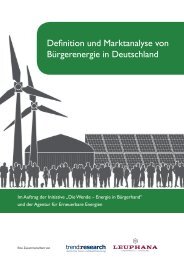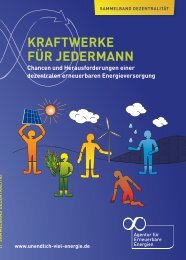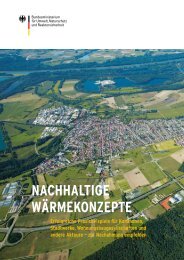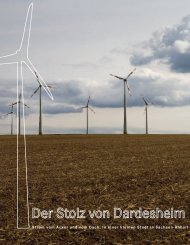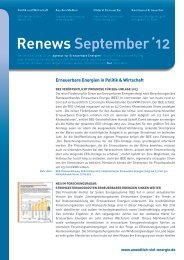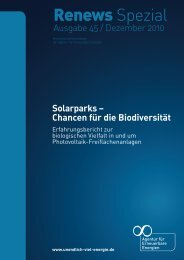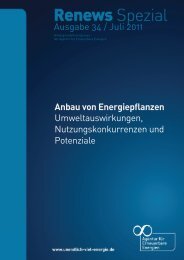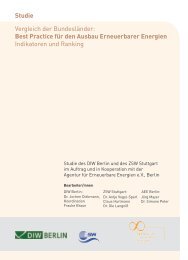Solar parks - Agentur für Erneuerbare Energien
Solar parks - Agentur für Erneuerbare Energien
Solar parks - Agentur für Erneuerbare Energien
You also want an ePaper? Increase the reach of your titles
YUMPU automatically turns print PDFs into web optimized ePapers that Google loves.
Renews Special Best practice recommendations Issue 45 | p 20<br />
A new pond on the site of the solar plant in Salmdorf serves as stepping-stone biotope for the green toad (Bufo viridis, a threatened species, Red List category 1).<br />
(Photos: Richard Bartz , Michael von Ferrari)<br />
Another example is the solar park in Waldpolenz. The NABU criteria were taken as a basis for the<br />
environmental assessment of what used to be the world’s largest solar park. The minimization of the<br />
sealed area requested in the environmental report was implemented. The canopy effect of the arrays<br />
accounts for less than 50 per cent of the total area, in line with the NABU criteria. The environmental<br />
report prescribes that the existing grassland structure should be maintained and improved through<br />
the use of extensive grazing and mowing. It also stipulates that the fencing around the plant must not<br />
present an insurmountable obstacle to small mammals and amphibians.<br />
During the realization of the Sulzemoos solar park in Bavaria, a comparative forecast was produced<br />
relating to the change in environmental status of an arable site measuring around 7 hectares. It<br />
predicted an improvement in the environmental quality of the area as a result of the solar park. Plots<br />
covering around 1.3 hectares were earmarked for compensatory measures and implemented within the<br />
development area. The sides of a ditch adjacent to the development area were flattened over 1-3 metres<br />
at intervals along half the length to improve the natural dynamics and water retention. A strip about<br />
eight metres wide along the ditch serves as a transition zone between the site and the nearby forest.<br />
The remaining area was turned into extensive grassland. New native hedges were planted that provide<br />
hunting grounds and nesting places for the red-backed shrike, an endangered bird species.<br />
Compensation areas are particularly important for building projects in environmentally sensitive areas.<br />
In general, the construction of solar <strong>parks</strong> on brownfield sites can go a long way towards undoing existing<br />
environmental damage by unsealing sites and removing contamination where appropriate. The negative<br />
impacts on the European bird sanctuary caused by the solar park in Lieberose Heide required special,<br />
extensive compensatory measures. Because it was contaminated with military materials, the area on<br />
which the solar park was built was previously a prohibited zone. As a result, a succession woodland had<br />
developed over the years, threatening the habitats of ground-nesting birds and of those that depend<br />
on open areas with little vegetation. By preserving and reinstating the open land habitats and some<br />
forest habitats over an area of around 100 hectares, the solar project was able to conserve the habitat<br />
for certain bird species. This led to an improvement in the environmental status of the site, and means<br />
that the habitat can be preserved for specialized bird species like the tawny pipit and hoopoe for years<br />
to come.<br />
p 21 | Issue 45 Renews Special <strong>Solar</strong> <strong>parks</strong> – Opportunities for Biodiversity<br />
Lieberose solar park<br />
monitoring plan<br />
<strong>Solar</strong> plant<br />
Runway<br />
Cultivation and<br />
development zone<br />
<strong>Solar</strong> plant<br />
Southern<br />
compensation area<br />
At the Lieberose solar park, compensation areas were created on a total area of 100 hectares. (Illustration: Bosch & Partner GmbH)<br />
2.2. Measures during construction<br />
Development of open areas: moorland<br />
combined with bare earth and sparse sandy<br />
grassland<br />
Development of shrub areas<br />
Development of complex woodland<br />
Open land for the tawny pipit<br />
a. Environmental construction planning and monitoring<br />
Environmental quality assurance should be taken into account at the planning and approval stage, before<br />
construction work starts. The environmental monitoring expert is responsible for taking all relevant<br />
concerns into account before and during construction and for supervising the implementation of and<br />
adherence to defined conservation and abatement measures. This can avoid environmental damage<br />
during the construction phase. The expert can achieve this by taking part in construction meetings, by<br />
advising the construction site management and through regular site visits. Environmental construction<br />
monitoring raises awareness of environmental concerns within the companies involved. It means that<br />
a whole range of factors that could potentially have an adverse effect at the various levels of biological<br />
diversity can be included in the planning process and taken into account during construction.<br />
Environmental construction monitoring was employed when a photovoltaic plant was built on the roof<br />
of the water cistern in Berlin-Tegel, an area covered with grassland habitats. The underground cistern<br />
is about 40 years old and is used to store drinking water. This is technically a roof-mounted solar plant,<br />
but it looks like a ground-mounted plant. In order to avoid damaging the protected biotopes more than<br />
necessary during the construction work, particularly stringent standards were imposed. At the planning<br />
stage, the area required for the building work was minimized. Assembly work was carried out by hand<br />
without the use of machinery. The access routes were covered with geo fleece to protect them against<br />
trampling damage. Protected plants and those on the Berlin red list were transplanted to suitable<br />
locations on the Tegel waterworks site before building work started.



